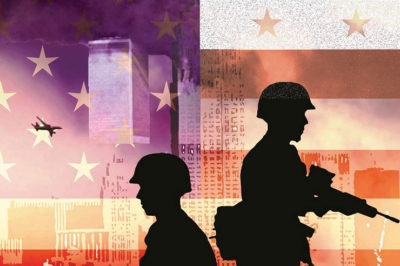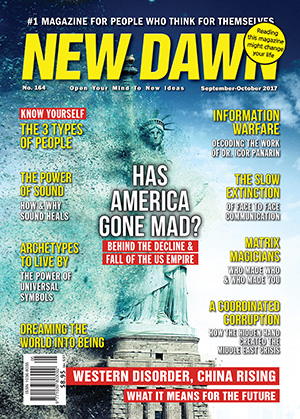From New Dawn 164 (Sept-Oct 2017)
In the second part of this series, MARC STAR examines ignored or suppressed events connected to the September 11, 2001 attacks and the real reasons for the war against Iraq (read Part One here).
9/11 and the Plan to Remake the Middle East
In the United States of the 1990s, officials within the Clinton administration were well aware of the growing threat of global terrorism. From the original World Trade Center bombing in 1993, the bombings of Kenya and Nairobi in 1998, the foiled Millennial Plot at the turn of the century, and the attack on the USS Cole in 2000, counterterrorism had become an official priority and a covert policy. Public policy, however, consisted of NATO wars, Iraq’s UN weapons violations and the President’s Oval Office inequities with female interns.
In 1998, Iraq ceased cooperating with UN weapons inspectors after accusing UNSCOM (United Nations Special Commission) of running cover for a CIA spying program. In response, the US pulled out the inspectors and began Operation Desert Fox, a bombing campaign that, as UN weapons inspector Scott Ritter would later note, “…had nothing to do with weapons production capability, but rather the leadership and security establishments of the government of Iraq and that the precision in which these targets were bombed was due in large part… to the information gathered by weapons inspectors.”28
Mr. Ritter’s account of his years as a weapons inspector details his unfolding realisation the CIA was using UNSCOM as a cover to spy on Iraq. In January 1999, US government employees admitted as such to the Washington Post and Boston Globe with, as the newspapers claimed, documentation to back it up. American officials substantiated the allegations later that month – all, however, under the cover of anonymity.29
Nevertheless, by 2000 a division within the CIA was interested in developing a covert dialogue with Iraqi diplomats to foster a framework for peace. Perhaps it was clear that Saddam was not going to step down or be deposed. Perhaps public support for bombing campaigns and sanctions had dried up. Or perhaps, just as UN weapons inspectors were used as cover for a CIA spying program, the CIA wanted a cover in the Iraqi embassy.
This division of the CIA chose a declared peace activist, Susan Lindauer, to be its liaison with Iraqi diplomats.
In the overt world, Ms. Lindauer had been, most notably, a congressional staffer. Covertly, she had been a CIA asset for years, working in the 1990s with Libyan diplomats “for the hand over of accused Lockerbie bombers to Scottish authorities”30 on behalf of her liaison at the CIA, Dr. Richard Fuisz.
In 2000, Dr. Fuisz gave Ms. Lindauer the opportunity to bring her negotiating talents to the issue of Iraqi weapons inspections.
“It would be a One-Woman Experiment with a new and wholly different approach to counter-terrorism. Success would depend on my ability to cultivate difficult relationships with… Iraqi diplomats in the opposite direction of official US policy,” she wrote.31 But, of course, it wasn’t only about peace. “[The CIA] wanted to leverage access from my activism to these embassies because they understood that Iraq and Libya had the best intelligence on terrorist activity in the Middle East. And the US needed to capture that intelligence.”32
By 2001, the relationships Ms. Lindauer had developed would prove to be of paramount importance as the chatter of an impending event grew to a near deafening volume.
9/11 Warnings
When President George W. Bush took office at the beginning of 2001, he was not interested in the threat of terrorism – despite alarm bells being rung by Richard Clarke, the National Coordinator for Counterterrorism, or the regular warnings given by CIA Director George Tenet and his analysts.
Instead, as later revealed by former Treasury Secretary Paul O’Neill, the Bush administration was drawing up plans and looking for excuses to invade Iraq from January 2001. According to Mr. O’Neill, “Ten days in, and it was about Iraq.”33
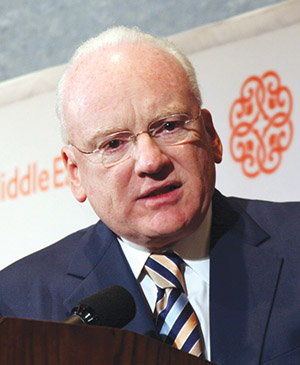
Mr. Clarke noted that in regards to funding, the Bush administration “had not placed terrorism in the top-priority issues for the Justice Department.”34 Additionally, Mr. Clarke’s position as National Coordinator for Counterterrorism (or Terrorism Czar, as the press labelled him) was downgraded below the status of principal. During the Clinton administration, he had been included in top-level meetings. After Bush took office, Mr. Clarke was excluded and, as he describes it, ignored.
Nevertheless, Mr. Tenet would plainly note, “at CIA, we knew al-Qa’ida was coming.”35
By 6 August, the intelligence community couldn’t have been clearer. In a now-famous President’s Daily Brief entitled “Bin Ladin Determined to Strike in US,” hand-delivered to Bush, he reportedly dismissed the PDB and responded, “You’ve covered your ass, now.”36 The 9/11 Commission later concluded that not only was no further action taken by Bush in response to this memo, “We have found no indication of any further discussion before September 11 among the President and his top advisers of the possibility of a threat of an al Qaeda attack in the United States.”37
Bush’s National Security Adviser, Condoleezza Rice, in 2004, testified to Congress: “Let me read you some of the actual chatter that was picked up in that spring and summer. ‘Unbelievable news coming in weeks’, said one. ‘Big Event. There will be a very, very, very, very big uproar. There will be attacks in the near future’. Troubling, yes, but they don’t tell us when. They don’t tell us where. They don’t tell us who. And they don’t tell us how.”38 It is almost unconscionable that the administration in charge of the United States of America, without being spoon-fed a specific when, where, who and how, would instead simply choose to do nothing.
Truth is, there was more than enough intelligence available to put the puzzle pieces together. The only thing missing was leadership from the top and a cohesive policy. In other words, the President should have gotten off the golf course and done his job because that summer’s prize capture, Zacarias Moussaoui, the alleged “20th hijacker,” was found in possession of flight manuals for the Boeing 747 Model 400, a flight simulator computer program, software that could be used to review pilot procedures for the Boeing 747 Model 400 and more.39 FBI Minneapolis Chief Division Counsel Coleen Rowley would later blow the whistle that within days of Moussaoui’s arrest, “the French Intelligence Service confirmed [Moussaoui’s] affiliations with radical Islamic fundamentalist groups and activities connected to Osama bin Laden.”40
While the Bush administration was wilfully and knowingly asleep at the wheel in 2001, the intelligence community was not. That summer, Dr. Fuisz tasked Susan Lindauer to deliver a message to the Iraqi embassy. As the United States had no official communication channels with Iraq, Ms. Lindauer found herself in the role of messenger.
Dr. Fuisz instructed her to demand that, “‘Iraq must hand over any intelligence regarding conspiracies involving airplane hijackings or airplane bombings… The United States would bomb Baghdad back into the Stone Age… if [we] discovered a terrorist conspiracy involving airplane hijackings or airplane bombings and [Iraq] failed to notify us. They would lose everything. We would destroy them. Those threats originated at the highest levels of government’, and I quote, ‘above the CIA Director and the Secretary of State’.”41
Ms. Lindauer added, “There’s no question that months before 9/11, a cabal of pro-War neo-Conservatives at the top of the government was already prepping the Intelligence Community to accept War with Iraq in the aftermath of a strike.”42
A close friend of Ms. Lindauer, Parke Godfrey, a tenured associate professor in the Department of Computer Science and Engineering at York University in Toronto, Canada, would later testify at a court hearing in June 2008 that Ms. Lindauer did share with him, in the summer of 2001, warnings of the impending terrorist attack.
“In the spring and summer of 2001, on several occasions Ms. Lindauer expressed heightened concern that a terrorist attack was in the works that would strike the southern part of Manhattan. She claimed it would reprise the 1993 attack on the World Trade Center.”43
9/11
The story of 11 September 2001 is one of fascinating coincidences and absurd anomalies. Perhaps the most amazing coincidence is the incredible story of the Naudet brothers, Jules and Thomas, two filmmakers who happened to be shooting a documentary about the firemen of Engine 7, Ladder 1, the closest firehouse to the World Trade Center complex. Brother Jules happened to be on the streets of Lower Manhattan that morning with a small crew of firefighters responding to a gas leak – at a spot that gave Mr. Naudet a clear view of American Airlines Flight 11 as it flew overhead before impacting the North Tower between the 93rd and 99th floors. Mr. Naudet’s footage is, as far as the public knows, the only footage of the impact of Flight 11, the first plane to strike.
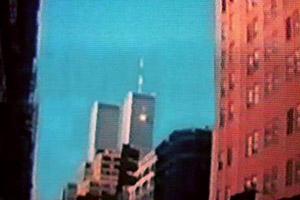
That morning, President Bush was reading a children’s book to a class of second graders. However, he would later say, “I was sitting outside the classroom, waiting to go in, and I saw an airplane hit the tower. The TV was obviously on. I used to fly myself, and I said ‘There’s one terrible pilot’.”44
But Jules Naudet’s footage of Flight 11 wasn’t broadcast on television until long after both towers had collapsed and Jules had made his way through the dust. What footage did President Bush claim to see that morning?
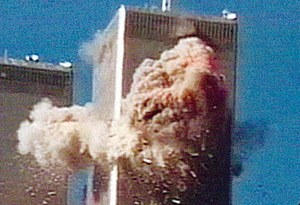
One might even wonder how hijacked airplanes could possibly confound the world’s most sophisticated air defense system, NORAD (North American Air Defense). The answer to this may lie in a military exercise being conducted that day called Vigilant Guardian, a semi-annual drill that, among other things, simulates plane hijackings. In 2006, Vanity Fair had the opportunity to review the NORAD tapes.
“For the neads [Northeast Air Defense Sector] crew, 9/11 was not a story of four hijacked airplanes, but one of a heated chase after more than a dozen potential hijackings – some real, some phantom – that emerged from the turbulence of misinformation that spiked in the first 100 minutes of the attack… At one point, in the span of a single mad minute, one hears [Major Kevin] Nasypany struggling to parse reports of four separate hijackings at once.”45
Following the impact of United Airlines Flight 175 into the South Tower, Bush’s chief of staff Andy Card entered the classroom and whispered in his ear, “A second plane hit the second tower. America is under attack.” Bush then took to the air within Air Force One while Vice President Cheney holed up in the President’s Emergency Operations Center (PEOC), an underground bunker beneath the White House. The task of managing the 9/11 crisis fell entirely on the shoulders of Richard Clarke, the recently demoted National Coordinator for Counterterrorism.
“I was most of the day, the nation’s crisis manager,” Mr. Clarke would later recount. “The government had largely fled Washington.”46
Safely underground in the PEOC bunker, the senior official of the executive branch of the United States government at the White House, Vice President Dick Cheney, was actively cutting off communication between his PEOC bunker and the crisis management team in the White House Situation Room, led by Mr. Clarke. At the outset of the crisis, Mr. Clarke sent Army Major Mike Fenzel into the PEOC to maintain an open line with him in the Situation Room. In the midst of it all, “Major Fenzel whispered, ‘but I can’t hear the crisis conference because Mrs. Cheney keeps turning down the volume on you so she can hear CNN… and the Vice President keeps hanging up the open line to you.”47
Susan Lindauer, meanwhile, was on the phone with her CIA handler, Dr. Fuisz. He knew, somehow, about the existence of video footage showing the first plane hitting the North Tower.
“‘How often does a bystander have a camera cued up to record a car accident on the street?’” Ms. Lindauer would later quote him telling her. “‘It never happens, Susan. It never happens’.” He would then add one of the most disturbing revelations of that day. “‘Those are Israeli agents’,” he told her. “‘They were waiting for it all morning’.”48
Israeli Spies
This brings us to perhaps the most controversial aspect of 9/11 – the Israeli connection. While Dr. Fuisz’s comment to Ms. Lindauer is, on its face, hearsay, an additional incident that occurred on 9/11 stands out as more than simply anomalous – the strange case of the so-called “dancing” Israelis.
As the Twin Towers burned that morning on 9/11, three young men were seen atop the roof of a white van taking photos of themselves with the World Trade Center ablaze in the background. The woman who reported the incident later said, “They were like happy, you know…” She wrote down the van’s license plate number and reported it to the police. When the van was pulled over later that day, five men were found inside. The driver told the arresting officer, “We are Israeli. We are not your problem. Your problems are our problems. The Palestinians are the problem.”49,50
The white van belonged to Urban Moving Systems. The FBI questioned the company’s owner, Dominik Otto Suter, an Israeli citizen, not only about the five detained Israelis, but also, “oddly,” as the FBI report stated, about another Urban Moving Systems truck stopped in Pennsylvania, headed towards the direction of Shanksville, the location where Flight 93 crashed. Mr. Suter told the FBI that the truck had no scheduled pickups or deliveries outside of New Jersey that day.51 Following the interview, Mr. Suter fled back to Israel. When the New York State Department of Transportation learned that the company’s main office was only a mailing address, its business license was revoked.52
Four of the arrested Israelis passed lie detector tests. A fifth, Paul Kurzberg, refused. Ten weeks later, however, Mr. Kurzberg finally agreed to test and failed. After 71 days in jail, the five Israelis were charged with visa violations and deported. The FBI closed its case, concluding that “no basis” was found to suggest that four of the Israelis were “in possession of or had any prior knowledge relating to the attacks on the World Trade Center of 9/11/01.” The FBI, however, found “no articulate facts… to demonstrate” that the “least cooperative” of the five Israelis “was in possession of or had any prior knowledge…”53 In other words, the FBI couldn’t make the case on Paul Kurzberg, despite a potential basis for doing so.
Forward, an American Jewish weekly, was able to get to the bottom of the story. According to a “former high-ranking American intelligence official… the five Israelis arrested in New Jersey last September were conducting a Mossad surveillance mission and… their employer, Urban Moving Systems… served as a front.” The mission was to spy on “a common enemy… radical Islamic networks suspected of links to Middle East terrorism.”54
The Forward article concludes with a quote from Chip Berlet, a senior analyst at the Boston-based Political Research Associates, noting a “backdoor agreement between allies that says that if one of your spies gets caught and didn’t do too much harm, he goes home. It goes on all the time. The official reason is always a visa violation.”
Harmless enough, until one more incident is taken into account. Prior to 11 September, a group of 120 Israeli “art students” were rounded up as part of a “widespread investigation into a suspected espionage ring run by Israel inside the USA.”55 One group of students resided in Hollywood, Florida, “just down the block from the 3389 Sheridan St. apartment where terrorist mastermind Mohammed Atta holed up with three other Sept. 11 plotters.”56 According to a French intelligence report on the “art student” bust, “Mossad agents were spying on Mohammed Atta and Marwan al-Shehi, two of [the] leaders of the 9/11 hijack teams.”57
Vincent Cannistraro, former chief of operations for counterterrorism with the CIA, told journalist Christopher Ketcham, “the FBI investigation [of the ‘dancing’ Israelis] operated on the premise that the Israelis had foreknowledge.” But the investigation was quashed. And the order to do so came from the top. A former CIA counterterrorism officer also told Mr. Ketcham, “There was no question but that [the order to close down the investigation] came from the White House. It was immediately assumed at CIA headquarters that this basically was going to be a cover-up so that the Israelis would not be implicated in any way in 9/11.”58
Some Mossad agents had foreknowledge. Some at the White House had foreknowledge. The events that unfolded indicate they knew each other knew, at least after the fact.
The 800-pound gorilla in the room, however, is the question of why Mossad agents would have been publicly celebrating on 9/11, conducting themselves in a way to attract the most attention? And why would Israeli spies posing as art students have “an inexplicable interest in peddling art to G-men”?59 Aside from the fact that both missions have been identified as surveillance programs to track Islamists in America, both sets of agents behaved in a manner that suggests they intended to be caught.
And Then the Towers Disappeared
Amidst the tragedy of 11 September 2001, an anomaly occurred that should give everyone pause for thought. It is a story of 14 firemen and an office worker trapped between the first and the sixth floors of the North Tower’s B stairwell when the tower disintegrated – the only people from inside either disintegrating tower who lived to tell the tale – and it was later immortalised in a UK broadcast documentary The Miracle of Stairway B.60
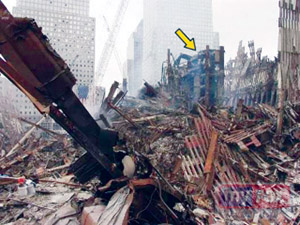
After the second plane hit, firemen were on their way up the North Tower, while office workers were on their way down. About an hour into the firemen’s journey, they had reached the 31st floor, which is when the South Tower disintegrated, causing such an earth shaking rumble that the firemen in the North Tower’s stairwell B were thrown to the floor. Captain Jay Jonas soon gathered that the South Tower had “collapsed.” He knew that his men were now in a race against time to descend the 31 floors they had just climbed. But they didn’t make it out.
As the North Tower disintegrated, “you could actually hear the floors hitting one another,” fireman Sal D’Agostino said. “Boom, boom, boom, boom. And as it fell, it got faster” (emphasis added). One hundred floors of the North Tower and more than a half million tons of material were presumably falling down upon them. Truth was, the 110-story tower disintegrated in just under 10 seconds – except for one pocket of the building in which fourteen people were left untouched.
The building didn’t fall down upon them. It disintegrated around them. Hours later, when the dust cleared, something amazing happened.
“All of the sudden, a ray of sunshine hit the stairwell,” said Captain Jonas.
“It was clearly sunlight,” added fireman Mickey Kross. “A 110-story building fell down on top of us, and I’m on the third floor looking at sunlight.”
The documentary claimed that, “experts… offered a tentative explanation. The tower fell with its exterior collapsing outwards at a faster rate than its interior, leaving a protected stump towards the base of the building.” Such an explanation, however, ignores one enormously crucial necessity: the cause of the “collapse.” The collapse hypothesis requires a ten-story section above the impact point of each tower crushing the floors below it.
The only problem with this hypothesis – which any cursory study of top-down images of ground zero will confirm – is that no ten-story sections are evident at the site. Absent the evidence of these ten-story sections at ground zero one must question the collapse hypothesis.
This lack of rubble was not lost on ABC News anchor Peter Jennings who, on 12 September, asked a question that bears repeating.
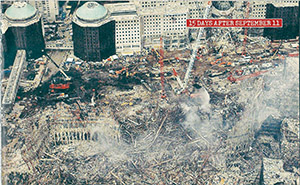
Mr. Jennings asked George Stephanopoulos, “[ABC News correspondent] Jackie Judd and several other people keep asking us, when you look at where the towers used to stand, there is surprisingly so little rubble. Where did all the rubble go?”
Mr. Stephanopoulos, the ABC reporter at Ground Zero, responded: “The reason there is so little rubble is that all of it simply fell down into the ground and was pulverized, evaporated.”61
The ten-story sections that supposedly crushed the 90-plus stories of building below them hit the ground and evaporated.
Magic.
The Plan
In March 2007, Amy Goodman of Democracy Now! interviewed Wesley Clark, a retired American four-star general who had commanded allied forces in the Kosovo War during his term as the Supreme Allied Commander Europe of NATO from 1997 to 2000. By 2007, the American war on Iraq had become an embarrassment, and insiders wanting to distance themselves from the Bush administration’s misadventures, were speaking freely. General Clark recounted a story that still has meaning today.
“About 10 days after 9/11,” General Clark said, “I went through the Pentagon [to see] Secretary Rumsfeld and Deputy Secretary Wolfowitz. I went downstairs just to say hello to some of the people on the Joint Staff who used to work for me, and one of the generals called me in. He said, ‘Sir you’ve got to come in and talk to me a second… We’ve made the decision we’re going to war with Iraq.’ …I said, ‘We’re going to war with Iraq? Why?’ He said, ‘I don’t know… I guess they don’t know what else to do’.
“So I came back to see him a few weeks later, and by that time we were bombing in Afghanistan. I said, ‘Are we still going to war with Iraq?’ And he said, ‘Oh it’s worse than that… I just got this down from upstairs’ – meaning the secretary of defense’s office – ‘…This is a memo that describes how we’re going to take out seven countries in five years, starting with Iraq, and then Syria, Lebanon, Libya, Somalia, Sudan and finishing off Iran’.”62
Love/Hate Affair With Saddam
Your government allowed this to happen to its own people, so you could declare war on us.
– Iraqi diplomat to Susan Lindauer after 9/1163
Elements within the government of the United States were no doubt itching to invade Iraq to not only clean up the mess the West created when it supported the Ba’athists to power in the late 1960s, and gain control of Iraq’s oil fields – a fuel-hungry military sweep through the Middle East was looming – but it also would be the beginning of a plan to subdue geopolitically relevant Middle Eastern countries not aligned or subordinated to the Western corporate power structure.
The CIA had initially helped the Ba’athists take power in 1960s Iraq to oust Prime Minister Abdel Kassem, a pro-communist who withdrew Iraq from the pro-West Baghdad Pact and opposed foreign forces on Iraqi soil. The CIA provided the Ba’athists with a list of communists and pro-leftists. The result was a bloodbath. “Soon, Western corporations like Mobil, Bechtel and British Petroleum were doing business with Baghdad – for American firms, their first major involvement in Iraq.”64

But that relationship soured when Iraq nationalised its oil resources in 1972 and expelled Western oil companies. Saddam Hussein rose to power in 1979. It is now clear that the subsequent Iran-Iraq War, started when Iraqi forces invaded Iran, developed into a wilful effort to weaken two countries that weren’t playing ball with Western petroleum companies. In order to “avoid victory by both sides,”65 the US backed Iraq with covert arms shipments, while Israel clandestinely shipped US arms to Iran (in addition to secret US arms shipments to Iran that came to light during the Iran/Contra scandal in 1980s America).
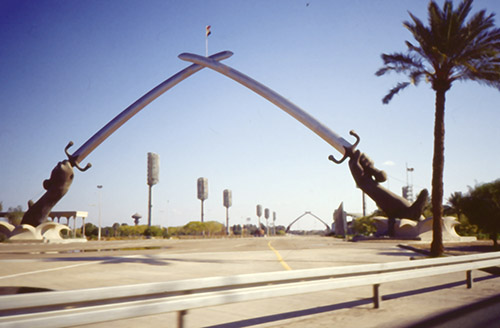
When the war ended in August 1988, Iraq’s coffers had bled dry. Iraq was in debt to the tune of $80 billion, the bulk owed to surrounding Gulf states. Meanwhile, oil prices were dropping.
“By 1990, he [Saddam Hussein] was regularly defaulting on payments to his Arab creditors, particularly Kuwait, which held some $10 billion of Iraq’s debt.”66 But the drop in oil was no accident. Kuwait and the United Arab Emirates were overproducing, driving the prices down. Exacerbating the situation, Iraq claimed Kuwait was siphoning oil from the Rumaila oilfield underneath the Iraqi side of the border.
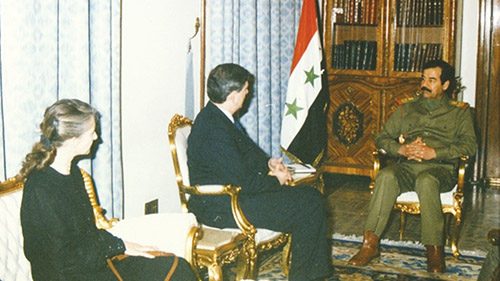
As Iraqi forces massed along the border with neighbouring Kuwait, the US State Department and President George H. W. Bush, in official statements, took no position on the brewing conflict.67 US Ambassador April Glaspie told Saddam, “[W]e have no opinion on the Arab-Arab conflicts, like your border disagreement with Kuwait.”68 State Department spokeswoman Margaret Tutwiler stated, “We do not have any defense treaties with Kuwait, and there are no special defense or security commitments to Kuwait.”69 Ambassador Joseph Wilson would later write that Assistant Secretary of State John Kelly declared: “We don’t have any defense treaty with the Gulf States. That’s clear.” Ambassador Wilson added, “Within minutes, Kelly’s testimony was transmitted to Iraq.”70
Like the Soviet “Afghanistan trap,” Mr. Brzezinski might have categorised Iraq’s invasion of Kuwait as such: We didn’t push Iraq to invade Kuwait, but we knowingly increased the probability that it would.
Iraq’s invasion of Kuwait was followed by America’s Gulf War of 1991, the first salvo of a twelve-year process by which Iraq was beaten and slowly bled dry. By 2003, sanctions and ongoing bombing campaigns had effectively destroyed the country’s economy, infrastructure and military – well before Americans fired the first shot during the March 2003 invasion.
The Afghanistan War of 2002 was primarily a CIA-led conflict, executed with a strategy that the CIA does best – purchasing support from local warlords and supplying them with the means to get the job done. The American military was barely involved and, notoriously, Osama bin Laden escaped. The full force of the United States war machine instead was being saved for Iraq.
“There was… a surety inside CIA – also widely held – that the President would eventually get his way and there would be an invasion,” wrote journalist Ron Suskind.71
The Islamists also knew Iraq was next. After the US started bombing Afghanistan, members of al Qaeda began fleeing to Iraq, including Abu Musab al-Zarqawi, who “began establishing local support networks in Baghdad,”72 later becoming the leader of al Qaeda in Iraq.
All that remained was for the Bush administration to create enough fear to sell the war to the American people and the United Nations.
The third and final part of this series appears in New Dawn 165.
Footnotes
28. Scott Ritter, Frontier Justice, Context Books, 2003, 37-38
29. Barton Gellman, “U.S. Spied On Iraq Via U.N.”, The Washington Post, 2 March 1999
30. Michael Collins, “American Cassandra – Susan Lindauer’s Story”, Scoop Independent News, 17 October 2007, www.scoop.co.nz/stories/HL0710/S00266.htm
31. Susan Lindauer, Extreme Prejudice, (self-published, 2010), 48
32. Lindauer, 60
33. Ron Suskind, The Price of Loyalty, Simon & Schuster, 2004, 75
34. Richard A. Clarke, Against All Enemies, Free Press, 2004, 256
35. Tenet, 187
36. Ron Suskind, One Percent Doctrine, Simon & Schuster, 2006, 2
37. Thomas H. Kean and Lee Hamilton, 9/11 Commission Report, National Commission on Terrorist Attacks Upon the United States, 2004, 261-262
38. “Testimony of Condoleezza Rice Before 9/11 Commission,” The New York Times, 8 April 2004
39. United States vs. Zacarias Moussaoui, Statement of Facts, Criminal No. 01-455-A, www.vaed.uscourts.gov/notablecases/moussaoui1/dktsheets/docs/70543/0.pdf
40. “Coleen Rowley’s Memo to FBI Director Robert Mueller”, Time, 21 May 2002
41. Lindauer, 20-21
42. Lindauer, 22
43. Parke Godfrey, Affidavit, 19 October 2009, extremeprejudiceusa.files.wordpress.com/2010/10/parke-godfrey-affidavit-on-911-warning.pdf
44. “On 9/11, Bush watched the first plane impact,” www.youtube.com/watch?v=BUXglJU2w6U
45. Michael Bronner, “9/11 Live: The Norad Tapes,” Vanity Fair, 17 October 2006,www.vanityfair.com/news/2006/08/norad200608
46. Clarke, 17-18
47. Clarke, 18
48. Lindauer, 95
49. Chris Isham, et al., “Were Israelis Detained on Sept. 11 Spies?”, 20/20, 21 June 2002, abcnews.go.com/2020/story?id=123885&page=1
50. Scott DeCarlo. East Rutherford Police Department, CSRR# 014157.
51. FBI, Unclassified report 2010-07-21 (Newark, NJ), Section 1, p. 36, archive.org/stream/FBIandPoliceReportUrbanMoving/dancing-israelis-fbi-document-section-1-1138796-001-303a-nk-105536-
section-1-944861.
52. Neil Mackay, “Five Israelis were seen filming as jet liners ploughed into the Twin Towers on September 11”, Sunday Herald, 02 November 2003, web.archive.org/web/20031202162323/http://www.sunday
herald.com/37707
53. FBI, Unclassified report 2010-07-21 (Newark, NJ), Section 6, pp. 54-56, archive.org/stream/FBIandPoliceReportUrbanMoving/
FBI-document-Section-6-1138796-001-303A-NK-105536-Section-6
54. Marc Perleman, “Spy Rumors Fly on Gusts of Truth”, Forward,15 March 2002, web.archive.org/web/20020323052403/http://www.forward.com/issues/2002/02.03.15/news2.html
55. Sunday Herald, 2 November 2003
56. Christopher Ketcham, “The Israeli ‘Art Student’ Mystery”, Salon,7 May 2002, www.salon.com/2002/05/07/students/
57. Sunday Herald, 2 November 2003
58. Christopher Ketcham, “What did Israel Know in Advance of the 9/11 Attacks?”, Counterpunch, vol. 14, no. 3/4, 3
59. Ketcham, “The Israeli ‘Art Student’ Mystery”
60. “The Miracle of Stairway B”, www.youtube.com/watch?v=EpTRNEVKMY4
61. “ABC News, ‘Where’s all the rubble gone?’ (12:44 pm 9/12/2001)”, www.youtube.com/watch?v=GdBQOe85i3M
62. “Gen. Wesley Clark Weighs Presidential Bid”, Democracy Now!, 2 March 2007, www.democracynow.org/2007/3/2/gen_wesley_clark_weighs_presidential_bid
63. Lindauer, 103
64. Roger Morris, “A Tyrant 40 Years in the Making”, The New York Times, 14 March 2003
65. Seymour Hersh, “U.S. Secretly Gave Aid to Iraq Early in Its War Against Iran”, The New York Times, 26 January 1992
66. Zachary Karabell, Philip Zelikow, “Prelude to war: US Policy Toward Iraq 1988-1990”, Harvard Intelligence and Policy Project, 1999
67. R. Jeffrey Smith, “State Department Cable Traffic on Iraq – Kuwait Tensions, July 1990,” Washington Post, 21 October 1992
68. Stephen M. Walt, “Wikilieaks, April Glaspie, and Saddam Hussein,” Foreign Policy, 9 January 2011
69. Elaine Sciolino, Michael R. Gordon, “Confrontation in the Gulf; U.S. Gave Iraq Little Reason Not to Mount Kuwait Assault”, The New York Times, 23 September 1990
70. Joseph Wilson, Politics of Truth, PublicAffairs, 2005, 104
71. Suskind, 189
72. Atwan, 197
© New Dawn Magazine and the respective author.
For our reproduction notice, click here.

